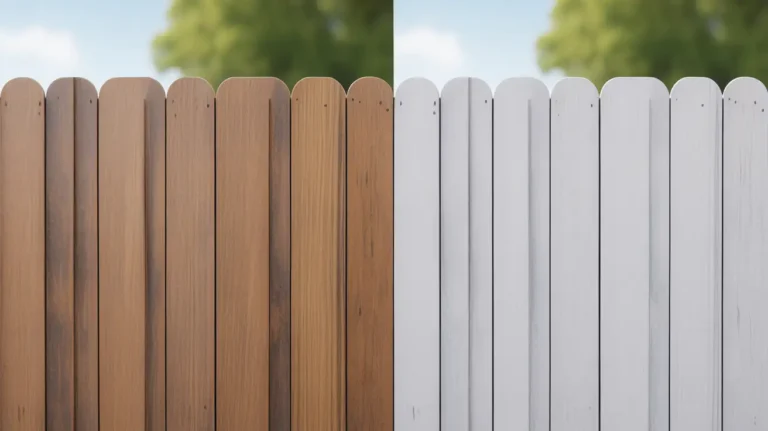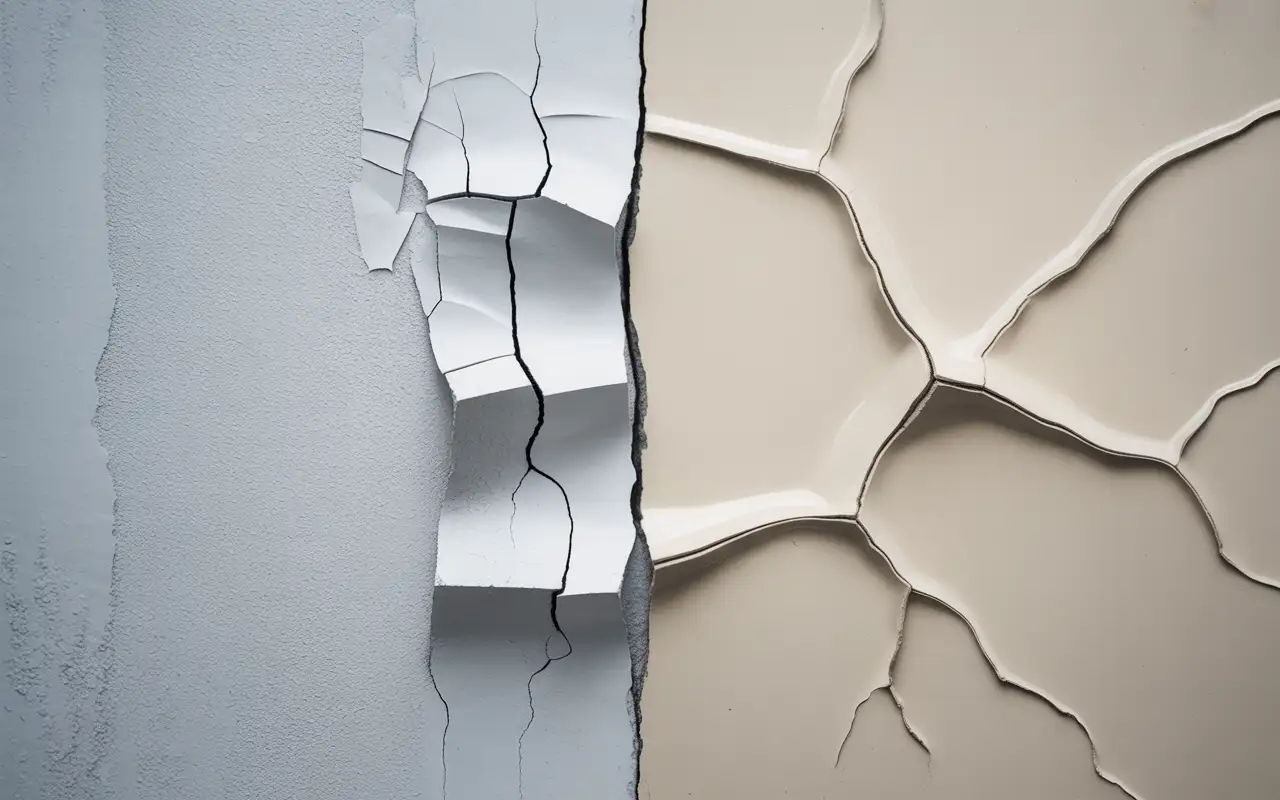Planning a home improvement project means choosing the right finish for your surfaces. The choice between paint and stain is one of the biggest decisions you will make, impacting both the look and the longevity of your wood. Understanding the difference between stain and paint is essential to getting a professional result that lasts.
Both are protective coatings, but they achieve their goals in totally different ways. We will break down exactly how they work, where to use them, and the real cost of each finish over time. This guide is based on professional experience and offers clear advice to help you pick the best option for your home.
Table of Contents
ToggleHow Paint and Stain Actually Work
Both products share three basic ingredients: pigment for color, solvent as the carrier, and binder to hold everything together. But the ratios matter.
Paint contains much more binder, which creates a thick coating that sticks to the surface. Think of it like a protective blanket covering your wood or concrete. You can’t see the material underneath anymore.
Stain has mostly solvent with less binder and pigment. This thin mixture penetrates porous surfaces like wood, enhancing the natural grain rather than hiding it. The material absorbs the color deep into its fibers.
Advantages and Disadvantages of Paint vs Stain

Making an informed choice requires looking at the practical pros and cons of each finish across the entire life of the product.
Paint (The Coverage King)
Advantage | Disadvantage |
Durability & Lifespan | Preparation is intensive. Requires scraping, sanding, and often a primer coat. |
Superior Protection | Traps moisture within wood if the seal is broken, leading to peeling and rot. |
Color & Sheen Variety | Higher upfront material cost, especially for premium latex paint. |
Hides Imperfections | Completely covers the natural grain of wood. |
Flexibility | Can be applied to many surfaces (wood, metal, drywall, stucco). |
Stain (The Natural Look)
Advantage | Disadvantage |
Ease of Application | Shorter lifespan; typically needs a re-coat every 2–5 years. |
Natural Aesthetics | Limited color options, mainly earth tones and wood shades. |
Maintenance | Easier to apply stain later. Can often apply stain over old stained surfaces without stripping. |
Resistant to Failure | Will not peel or crack, but it does fade gradually. |
Breathability | Allows wood to release moisture, which is better for exterior decks. |
Which finish is right for your surface?
Wood Applications
Wood is where the paint vs stain decision matters most. For decks, fences, and outdoor furniture, stain usually wins. It enhances wood surfaces while allowing them to breathe and release moisture naturally.
Use semi-transparent stains for newer wood when you want grain visibility. Solid stains work better on older wood with weathering or damage. These based stains (both oil based and water based formulations) penetrate differently depending on wood type.
Paint works better on wood trim, doors, and cabinets. The smooth, uniform finish looks cleaner on architectural elements. Oil based paint provides extra durability for high-traffic areas, while water based options offer easier cleanup.
Concrete and Masonry
Concrete stains create stunning patios, driveways, and walkways. Acid-based stains react with concrete’s chemistry, producing unique mottled patterns. Water-based concrete stains offer more color control and easier application.
Acid stains cost $3-$8 per square foot installed, while water-based versions run $2-$4 per square foot. Both penetrate the concrete and won’t peel like paint.
Latex paint on concrete and brick eventually fails. Moisture trapped behind the painted surface causes peeling within 2-3 years. If you must paint masonry, use specialized masonry paint and accept a shorter lifespan.
Drywall and Interior Walls
Paint is the only real choice for drywall. Stain soaks through the paper facing, creating blotchy, uneven results. Interior latex paint costs $20-$45 per gallon and provides excellent coverage.
You can choose from thousands of colors and various sheens and finishes. Use flat paint for ceilings, eggshell for living areas, and semi-gloss for kitchens and bathrooms.
Vinyl Siding
Vinyl doesn’t absorb stains because it’s non-porous. Paint is your only option, but use vinyl-safe paint that won’t warp the siding in heat. This specialized formula costs $35-$60 per gallon.
Clean vinyl thoroughly with soap and water before painting. Skip the primer since modern vinyl-safe paints adhere directly.
The Real Cost and Effort Comparison
Many people think stains are cheaper, but when you consider the lifespan and labor, the long-term cost difference may surprise you.
Lifespan and Maintenance
Surface | Paint (Premium Acrylic) | Stain (Semi-Transparent/Solid) |
Wood Siding | 8–12 years | 3–5 years |
Decking | 2–4 years (High risk of peeling) | 2–5 years (Wears naturally) |
Maintenance | Major labor is required to strip the surface when it fails. | Minimal prep for re-coat; often just cleaning. |
The Long-Term Value: Paint has a higher initial material cost (often $55–$80 per gallon) but lasts much longer on vertical surfaces like siding, making it the cheaper choice over a 20-year period. Stain (often $40–$70 per gallon) is cheaper to purchase and is easier to apply than paint, but the need for frequent re-coat cycles adds to the long-term labor cost.
Application Rules: An Important to Note Section
- Primer: Paint often requires a primer coat to ensure proper adhesion. Wood stains rarely need primer.
- Recoating: You can almost never successfully apply stain over a previously painted surface because the stain cannot penetrate the film-forming paint. The paint must be completely stripped down to the bare wood. It is easier to paint over stains, though a primer may still be necessary.
- Composition: Water based paints and water based stains are common now. They dry quickly and have lower Volatile Organic Compounds (VOCs), making them safer than traditional oil based versions with strong fumes.
Common Mistakes to Avoid
- Don’t apply too many coats of stain. More isn’t better. Excess stain sits on the surface and creates sticky, uneven spots. One good coat beats three mediocre ones.
- Never skip surface prep. Painting over dirt, grease, or failing coatings guarantees quick failure. Those hours of prep work pay off in years of durability.
- Don’t use interior products outside. Exterior formulations contain UV blockers and moisture resistance that interior paints and stains lack.
Which Should You Choose: Paint or Stain?
Your decision depends on three factors: surface type, desired appearance, and maintenance commitment.
Choose stain when you want to:
- Preserve natural wood grain and texture
- Work with wood decks, fences, or siding
- Save time on initial application
- Accept more frequent maintenance
- Finish concrete or masonry projects
Choose paint when you want to:
- Hide surface imperfections completely
- Get unlimited color options
- Paint non-wood surfaces like metal or vinyl
- Minimize long-term maintenance
- Create a modern, uniform look
Consider your climate too. Hot, sunny areas fade stains quickly, making paint more practical for south-facing surfaces. Humid regions with lots of moisture might do better with breathable stains that prevent trapped water.
Think about your skill level. Stains are easier to apply for DIY beginners. Mistakes blend in better, and you don’t need perfect technique. Paint demands more precision for professional-looking results.
Need Something Painted?
San Diego Custom Painting specializes in both interior painting and exterior painting services in San Diego. Our experienced team helps homeowners choose between stain and paint for every project.
We handle deck staining, fence painting, cabinet painting & refinishing, and complete home makeovers. Every job includes thorough surface preparation, premium materials, and detailed craftsmanship.
Contact us for a free estimate on your next painting or staining project. We’ll evaluate your surfaces, discuss your goals, and recommend the best solution for lasting results.
Frequently Asked Questions
Can I apply paint over an old stain?
Yes, you can apply paint over most stained finishes, but you must first ensure the surface is clean, dry, and dull. A quality bonding primer is highly recommended to ensure the new painted surface adheres well to the old stain.
What is a solid stain?
A solid stain contains a much higher concentration of pigment than a semi-transparent stain, offering coverage almost like paint. It hides the wood’s color but, because it is thinner, it still penetrates the wood more effectively than paint and is less likely to peel. It’s a great compromise for old wood.
Are all stains for wood?
No, that is a common mistake. There are distinct products like wood stains, concrete stains, and masonry stains. They have different compositions designed to work with the unique porosity and chemistry of the material they cover.
How many coats of stain are needed?
For wood stains, typically only one thin application or a maximum of coats of stain are needed. The goal is saturation, not layering. Excess stains should be wiped off. Paint, in contrast, often requires multiple coats to achieve proper color and protection.





